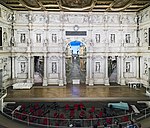Roman Catholic Diocese of Vicenza
Accuracy disputes from July 2023All accuracy disputesDioceses established in the 2nd centuryRoman Catholic dioceses in Veneto

The Diocese of Vicenza (Latin: Dioecesis Vicentina) is a Latin diocese of the Catholic Church in Italy. It is located in the region of the Veneto, and is the capital of the Province of Vicenza, approximately 60 km (37 mi) west of Venice, and around 45 km (28 mi) east of Verona. The diocese was in existence before 590. Vicenza was a suffragan of the Patriarchate of Aquileia until 1751. In 1751 it was transferred to the ecclesiastical province of Udine. In 1818, upon the dissolution of the ecclesiastical province of Udine, Vicenza was made it a suffragan of the Patriarchate of Venice.
Excerpt from the Wikipedia article Roman Catholic Diocese of Vicenza (License: CC BY-SA 3.0, Authors, Images).Roman Catholic Diocese of Vicenza
Leva' degli Angeli, Vicenza Santa Caterina
Geographical coordinates (GPS) Address Nearby Places Show on map
Geographical coordinates (GPS)
| Latitude | Longitude |
|---|---|
| N 45.55 ° | E 11.55 ° |
Address
Leva' degli Angeli 13
36100 Vicenza, Santa Caterina
Veneto, Italy
Open on Google Maps









